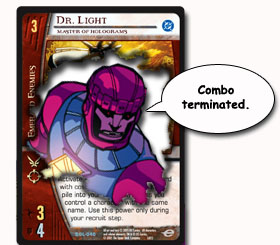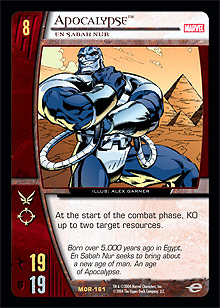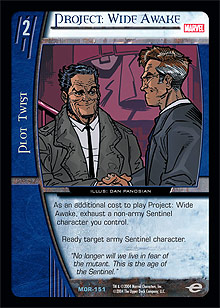
This weekend I won a Pro Circuit Qualifier. Normally I don’t concern myself with going to too many PCQs, as I’m already qualified for the next couple of Pro Circuits and I consider it a little cheeky to roll up and attempt to deny anyone else the privilege. However, given the world of fun that has been introduced by
Dr. Light, Master of Holograms and his pal
Rama-Tut, all of a sudden I had a reason to flex my Golden Age muscles and attempt to beat the new “best deck in the format.”
Metagames are in constant flux, and it isn’t uncommon for a new deck to fight for the position of “best deck” after a big showing in a $10K or a PC. The Dr. Light deck has more than a few people a little scared, though, so I was anxious to see just how tough a London PCQ with the new combo deck would be.
After some careful reading of my own article that covered a bunch of ways to go about disrupting Dr. Light’s powerful combo kill, I elected to use Sentinels as my weapon of choice for showing him who’s boss.
The rather naughty thing about Sentinels and the thing that has kept them at the top of the metagame for a disconcertingly large amount of time is that their core build, which provides a powerful curve of characters and enough plot twists to keep it in most games, leaves a remarkably high number of slots that can be dedicated to beating anyone who threatens them. When Betrayal was a concern, the robots could adapt with Mojoverse to stymie Betrayal’s effectiveness. When Fantastic Fun began winning $10K events in the hands of Dean Sohnle, Sentinels started packing a full complement of Micro-Sentinels. Most recently, Apocalypse has been showing up to sort out the various slower decks in the format whose control elements can hamper the purple robots.
The Dr. Light matchup for Sentinels is still a pretty scary one. While turn 3 kills don’t appear to be the norm, they can happen, and turn 4 kills are reliable enough that if the combo player takes the even initiative, any deck could falter, even with a bundle of tech. The good thing for Sentinels is that they have an abundance of ways to disrupt most nefarious schemes. In the main deck, there are seven copies of Sentinel Mark II that force Dr. Light to use an extra Cosmic Radiation when going off. Overload can also be helpful, allowing for a small respite if the combo player starts trying to be too clever with his or her counters early. This is especially effective on Kristoff Von Doom, The Boy Who Would Be Doom, as when stunned, the combo player is no longer considered to be controlling Doom.
 Initially in testing, we engineered a situation where Sentinels had a very good draw and Dr. Light had an average one. With enough copies of Sentinel Mark II in play, it was possible to slow down the combo deck sufficiently that it couldn’t win in time. This signaled that there might be hope for bringing down the doctor. It would appear that the matchup boils down to the effective number of copies of Cosmic Radiation that the combo player has compared to the amount of disruptors that are available to Sentinels. The best thing that can happen for Sentinels is for the combo deck to attempt to go off too early and effectively waste a Cosmic Radiation by walking into a trick. Dr. Light players have the somewhat tricky decision of whether to try to race through any potential resistance and win very fast, or to build up an unassailable hand and go off all in one turn in the reasonably late game with enough extra effects to ignore any disruption.
Initially in testing, we engineered a situation where Sentinels had a very good draw and Dr. Light had an average one. With enough copies of Sentinel Mark II in play, it was possible to slow down the combo deck sufficiently that it couldn’t win in time. This signaled that there might be hope for bringing down the doctor. It would appear that the matchup boils down to the effective number of copies of Cosmic Radiation that the combo player has compared to the amount of disruptors that are available to Sentinels. The best thing that can happen for Sentinels is for the combo deck to attempt to go off too early and effectively waste a Cosmic Radiation by walking into a trick. Dr. Light players have the somewhat tricky decision of whether to try to race through any potential resistance and win very fast, or to build up an unassailable hand and go off all in one turn in the reasonably late game with enough extra effects to ignore any disruption.
When I talk about the effective number of copies of Cosmic Radiation that the Dr. Light deck can muster, it can be well in excess of four, which might seem slightly counterintuitive. In addition to the plot twist itself, additional copies of Rama-Tut or Dr. Light, Master of Holograms will, assuming one has the resource points to play them, serve as additional Cosmic Radiations.
For the Sentinels player, there are inclusions that are versatile enough not to be crippling in other matchups that effectively Fizzle one of these Cosmic Radiation-esque effects. Have a Blast!, targeting either Devil’s Due when Rama-Tut’s return effect is on the chain or a team-up in response to Signal Flare, will buy valuable time by forcing an extra Cosmic Radiation. Devil’s Due is the strongest option to be hit by Have a Blast!, as it is the hardest element of the combo for the search-heavy Dr. Light deck to find (with Boris being the only option to get it). Potentially more powerful is Search and Destroy. If used in response to a Cosmic Radiation, it will always waste a single copy of the powerful plot twist. If one’s opponent (without another actual ready effect) doesn’t KO the targeted character in response using Devil’s Due, then one might hit an extra copy of Dr. Light! This rapidly makes winning the game very tough for the combo player.
The list that I ran at the PCQ was as follows:
Characters
4 Boliver Trask
2 Hounds of Ahab
7 Sentinel Mark II
7 Sentinel Mark V
4 Nimrod
4 Bastion
4 Magneto, Master of Magnetism
1 Apocalypse
Plot Twists
4 Savage Beatdown
4 Reconstruction Program
4 Overload
3 Nasty Surprise
3 Have a Blast!
3 Search and Destroy
2 Acrobatic Dodge
Locations
4 Genosha
 Within the PCQ in which I was competing, there weren’t any decks against which Apocalypse was ever needed, but his inclusion may well be necessary elsewhere so I don’t begrudge him a spot. Gamma Doom is another deck I would recommend for fighting Dr. Light, and as such, Apocalypse remains a good man who should probably occur in lists in multiples of two. Beatdown is having a hard time of it lately, so I ran a little light on defensive tricks. This isn’t necessarily a problem for the purple robots as long as one remembers how light the deck is on them, and as such, saves them for the more critical turns.
Within the PCQ in which I was competing, there weren’t any decks against which Apocalypse was ever needed, but his inclusion may well be necessary elsewhere so I don’t begrudge him a spot. Gamma Doom is another deck I would recommend for fighting Dr. Light, and as such, Apocalypse remains a good man who should probably occur in lists in multiples of two. Beatdown is having a hard time of it lately, so I ran a little light on defensive tricks. This isn’t necessarily a problem for the purple robots as long as one remembers how light the deck is on them, and as such, saves them for the more critical turns.
The story of the PCQ itself is not one that really requires huge amounts of comment. I faced Dr. Light once in the Swiss, losing on turn 4 before playing a single card in the most spectacular deck implosion that I have ever seen from Sentinels. Of course, all this did was spur me on to an even greater desire to start smashing faces with my powerful machines, which I duly did for the remaining Swiss rounds.
I wouldn’t recommend playing the “Swiss gambit” of getting into the losers bracket after round 1 and then winning from then on to avoid the best decks for as long as possible, but in this instance, it seemed to work rather well.
The field was about twenty percent decks planning to win on turn 3 with a mean combo, so I wasn’t surprised to see that I had to do a bit of combo breaking on the way to the finals. What I was a little surprised to see was a version of Phantom Phone Booth, the Team Superman extravaganza, staring me down in the finals. It would appear that the force was strong with the combo breakers in London that day, with Phantom Zone doing for the Man of Steel what Search and Destroy had done for me. Unfortunately for Superman, nobody had told the Sentinels that he is an immortal superhero with a bag of tricks large enough that only he is able to carry it. Search and Destroy proved its worth once again when it hit Superman, Red on turn 3, removing a further three copies of various Supermen from my opponent’s hand and allowing Mark the Combo Breaker and his big brothers Mark V and “Rod” to romp home to victory.
The big thing that I find intriguing for the future with Sentinels is that they seem to be playing in Vs. System in much the same way that they do in the comics. While someone might be able to bring them down one week, they have a nasty habit of adapting and coming back stronger to reclaim their top spot in following weeks. What remaining answers might they have to questions as yet unasked?
 Could Project Wide Awake start seeing play to ready Sentinel Mark II for extra combo breakery? Could Scarlet Witch supersede Nimrod to shut down any chance a combo deck has if it hasn’t won by turn 5? What of Magneto, Eric Lehnsherr taking Nimrod’s position and setting up huge Genosha activations on turn 6 for a quicker win against late game decks?
Could Project Wide Awake start seeing play to ready Sentinel Mark II for extra combo breakery? Could Scarlet Witch supersede Nimrod to shut down any chance a combo deck has if it hasn’t won by turn 5? What of Magneto, Eric Lehnsherr taking Nimrod’s position and setting up huge Genosha activations on turn 6 for a quicker win against late game decks?
One way or another, there seems to be ample potential for many more pitched battles in Golden Age. And as Longshot and his association with Sentinels can attest, it seems that betting against them is not a great idea in the long run.
Have fun and be lucky!
Tim “Combo Breaker” Willoughby
timwilloughby (at) hotmail (dot) com
Super Special Bonus Section: Getting Closure
There is a tricky situation that many players find themselves in where they let themselves get too attached to a pet deck, even when it isn’t necessarily the right choice for them in the metagame. I myself have been guilty of this. If you are having fun, it can be difficult to realize that the appropriate thing to do is to move on. I took a little break from the game after $10K Vienna last year to reappraise what I was doing and realized, for example, that the Titans build we had wrecked people with in Indianapolis just wasn’t appropriate for going forward in the metagame. This sort of distance is great for clarity. I still play with the old Titans build from time to time, and it won’t be disassembled any time soon, but I would urge everyone to be fluid in their thinking. Everything changes with time, and it is our duty to allow ourselves to do the same. Change and win. Win big. It can take a bit of a nudge to realize that it is time to move on, but it is your duty to realize that moving on is sometimes the best play.